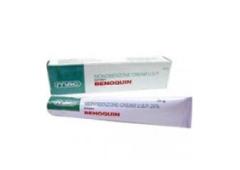Description
Vitiligo is a chronic skin condition characterized by the loss of skin color in patches, resulting from the destruction of melanocytes—the cells responsible for producing pigment. While vitiligo itself is not harmful or contagious, it can significantly impact an individual's self-esteem and quality of life. Over the years, various treatment options have been explored to manage vitiligo, one of which is Benoquin Cream.
Understanding Benoquin Cream:
Benoquin Cream, also known by its generic name monobenzone, is a depigmenting agent used in the treatment of vitiligo. Unlike treatments focused on repigmentation, such as phototherapy or topical steroids, Benoquin Cream works by permanently lightening the skin surrounding the vitiligo patches. This depigmentation helps to achieve a more uniform skin tone by blending the lighter patches with the surrounding skin.
How Benoquin Cream Works:
The active ingredient in Benoquin Cream, monobenzone, works by inhibiting the activity of tyrosinase, an enzyme involved in melanin production. Melanin is the pigment responsible for skin coloration. By suppressing melanin production in the areas where it is applied, Benoquin Cream gradually lightens the skin over time, effectively reducing the contrast between the unaffected and vitiligo-affected areas.
Application and Usage:
Benoquin Cream should be applied topically to the affected areas of the skin as directed by a healthcare professional. It is typically applied once or twice daily, depending on the individual's response to treatment. Before applying Benoquin Cream, it is essential to clean and dry the affected skin thoroughly to ensure optimal absorption.
Effectiveness and Results:
The effectiveness of Benoquin Cream in treating vitiligo can vary from person to person. Some individuals may experience significant depigmentation and improvement in skin tone, while others may see only modest results. It's important to note that Benoquin Cream does not cure vitiligo but helps manage its cosmetic appearance by depigmenting the skin.
Precautions and Considerations:
Before using Benoquin Cream, it is crucial to consult with a dermatologist or healthcare provider. They can assess the extent of vitiligo, discuss treatment options, and provide guidance on the proper use of Benoquin Cream. Additionally, individuals with a history of hypersensitivity reactions or allergic skin conditions should exercise caution when using Benoquin Cream.
Potential Side Effects:
While Benoquin Cream is generally considered safe when used as directed, some individuals may experience side effects or adverse reactions. Common side effects may include skin irritation, redness, itching, or a burning sensation at the application site. In rare cases, individuals may develop more severe reactions such as blistering, swelling, or hyperpigmentation.
Long-Term Use and Maintenance:
Benoquin Cream requires ongoing use to maintain its depigmenting effects. Once the desired skin tone is achieved, continued application may be necessary to prevent repigmentation and maintain uniformity. Regular follow-up appointments with a healthcare provider are essential to monitor progress, adjust treatment as needed, and address any concerns or side effects.
Conclusion:
Benoquin Cream offers a depigmentation approach to managing vitiligo, helping individuals achieve a more uniform skin tone and reduce the visibility of vitiligo patches. While it may not be suitable for everyone or provide complete repigmentation, Benoquin Cream can be an effective option for those seeking cosmetic improvement in their vitiligo-affected skin. As with any medical treatment, it is essential to consult with a healthcare professional to determine the most appropriate course of action based on individual needs and considerations.














